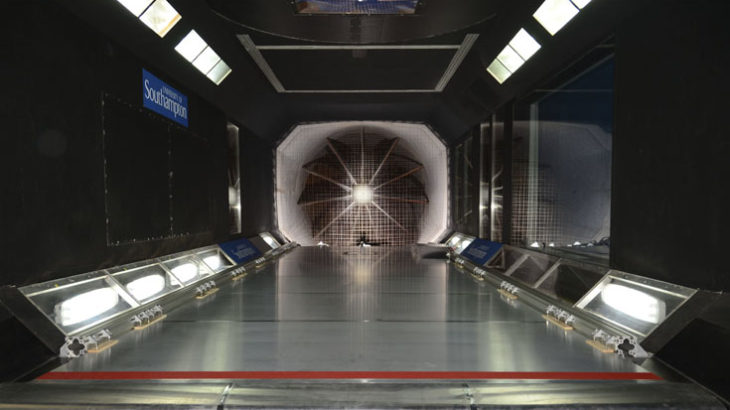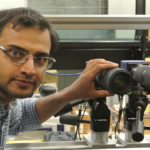Tunnel Vision Looks to Make Flying and Sailing Greener

An iconic wind tunnel once used to develop the Spitfire is now aiding 21st century efforts to help aircraft fly and ships sail more fuel-efficiently.Located at the University of Southampton, the R.J. Mitchell Wind Tunnel is being harnessed by Professor Bharath Ganapathisubramani’s team on an EPSRC and Airbus-backed project to deliver fresh insights into aerodynamic ‘drag’, and on research revealing how to cut fuel use and emissions in the shipping sector.
The tunnel also forms part of the National Wind Tunnel Facility (NWTF) – an imaginative new equipment-sharing initiative launched by SES members Imperial College London, Cambridge, Oxford and Southampton with City, Cranfield and Glasgow universities.
Test of Time
The spirit of the Spitfire still stalks the R.J. Mitchell facility, whose name immortalises the designer of the legendary World War Two fighter plane. In fact, the 3.5m-wide x 2.4m-high x 10m-long wind tunnel dates back to the 1920s, when it was first built at the Royal Aircraft Establishment in Farnborough. Donated 60 years later to Southampton University, extensively upgraded and with a CV that includes testing Formula One cars and assisting the successful 2012 British Olympic Cycling Team, the tunnel is now, appropriately, part of a new initiative blowing a wind of change through the world of UK research.
Led by Imperial and funded by the Engineering and Physical Sciences Research Council (EPSRC) and the UK Aerodynamics Centre, the NWTF:
- aims to keep the UK at the vanguard of aerodynamics and fluids research
- spans 17 world-class wind tunnels located at the seven universities
- has made the wind tunnels open-access, for up to 25% of the time, to researchers from across UK academia and industry.
“These are versatile facilities with a track record of delivering vital advances not just for the aerospace sector but for other industries too,” explains Bharath Ganapathisubramani, Professor of Experimental Fluid Mechanics at Southampton and a member of the NWTF’s Management Board. “Whether shedding light on underlying physics or engaging in development, testing and validation work, they’ve repeatedly shown their worth in the past and the goal is to widen their impact in the future. My current work using the R.J. Mitchell Wind Tunnel is proving how important the insights and vision produced by these facilities can be.”
“The NWTF’s wind tunnels are versatile facilities with a track record of delivering vital advances for the aerospace and other sectors“
Bharath Ganapathisubramani, Professor of Experimental Fluid Mechanics, University of Southampton
Something in the Air
For the aviation industry, the need to keep improving aircrafts’ aerodynamic performance is relentless. The drivers are both economic and environmental, as more efficient flying means:
- lower fuel consumption
- fewer damaging emissions
- longer aircraft lifetimes.
Ultimately, much of the scope to achieve these objectives revolves around finding new ways to combat ‘drag’ – the forces that oppose a body’s forward motion through a gas or a liquid.
“For a long time, we’ve known that drag is caused by turbulence near the surfaces of an aircraft,” says the Professor. “But now it’s recognised that some key causes may actually be found further from the surface. Working with the University of Toronto and with EPSRC support, we’re undertaking fundamental research to understand these mechanisms – research that could ultimately have big implications for the aviation industry, which is why Airbus is supporting a PhD student working on the project.”
Pivotal to the project’s success is the ability to break out beyond the confines of computer modelling work and experiments using small-scale wind tunnels, as the Professor explains: “Testing at a bigger scale makes it easier to detect previously unknown drag mechanisms. So it was a natural step to use the R.J. Mitchell Wind Tunnel, which generates wind speeds up to around 150km/h and is equipped with the top-quality lasers, cameras and other instrumentation we need to visualise and measure air flow accurately.”
One key technique being harnessed is Particle Image Velocimetry (PIV), which involves introducing smoke particles into a flow of air as it passes around a testing plate and then illuminating the flow with lasers.This makes the particles visible, showing the flow’s speed and direction and enabling generation of high-resolution images revealing the physical mechanisms contributing to drag. The project also aims to use its findings to develop drag reduction technologies that could be incorporated into aircraft – potentially of huge value to manufacturers and operators the world over.
Smooth Sailing Means Less of a Drag
The drag factor is not just confined to travel through the skies. In the seas, too, precisely the same principles apply – as does the need to understand the phenomena at work and find ways of mitigating them. Recognising this, the Southampton team are collaborating with the University of Melbourne and Indonesian university ITS on British Council-funded research to develop a clearer understanding of the relationship between the roughness of a ship’s hull and the amount of drag affecting the vessel. The precise aim is to answer two key questions:
- To minimise drag, what kind of surface finish might be required before an anti-fouling coating is applied to it?
- It’s clear that such coatings minimise fouling, but what drag is incurred by different fouled states and what is the cost/benefit perspective?
“Wind tunnels provide an ideal environment where different samples of roughness can be tested and their impact on drag explored,” Professor Ganapathisubramani says. “We’re building up a bank of data on the interrelationships between hull roughness, ship speed and fuel consumption and, uniquely, linking it to field experiments on a ship based in Indonesia. The results will obviously be of interest to the shipping industry but especially to hull-coating companies, which have to meet their customers’ needs cost-effectively while maintaining and maximising their own profitability.”
“Testing at a bigger scale makes it easier to detect previously unknown drag mechanisms“
Bharath Ganapathisubramani, Professor of Experimental Fluid Mechanics
Working across different sectors and meeting different needs, then, the R.J. Mitchell Wind Tunnel and other NWTF facilities look set to ensure that, when it comes to tackling all kinds of industrial and academic research challenges, there really is light at the end of the tunnel.
Further Information
EPSRC-funded aircraft drag research project
Facebook Featured image: J. Mitchell Wind Tunnel at the University of Southampton.
Main image:
J. Mitchell Wind Tunnel at the University of Southampton. Download full study.
Contact

Professor Bharath Ganapathisubramani
Professor of Experimental Fluid Mechanics (Faculty of Engineering and the Environment), University of Southampton

